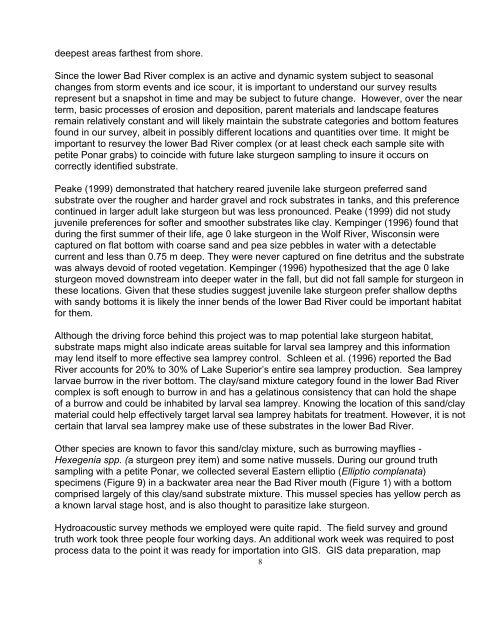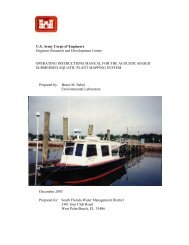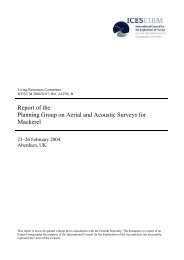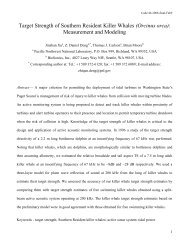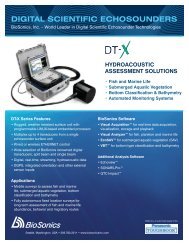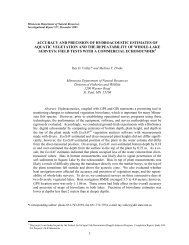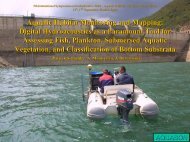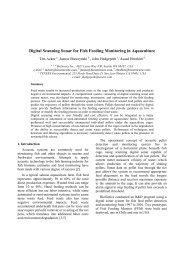Mapping Potential Lake Sturgeon Habitat in the ... - BioSonics, Inc
Mapping Potential Lake Sturgeon Habitat in the ... - BioSonics, Inc
Mapping Potential Lake Sturgeon Habitat in the ... - BioSonics, Inc
Create successful ePaper yourself
Turn your PDF publications into a flip-book with our unique Google optimized e-Paper software.
deepest areas far<strong>the</strong>st from shore.S<strong>in</strong>ce <strong>the</strong> lower Bad River complex is an active and dynamic system subject to seasonalchanges from storm events and ice scour, it is important to understand our survey resultsrepresent but a snapshot <strong>in</strong> time and may be subject to future change. However, over <strong>the</strong> nearterm, basic processes of erosion and deposition, parent materials and landscape featuresrema<strong>in</strong> relatively constant and will likely ma<strong>in</strong>ta<strong>in</strong> <strong>the</strong> substrate categories and bottom featuresfound <strong>in</strong> our survey, albeit <strong>in</strong> possibly different locations and quantities over time. It might beimportant to resurvey <strong>the</strong> lower Bad River complex (or at least check each sample site withpetite Ponar grabs) to co<strong>in</strong>cide with future lake sturgeon sampl<strong>in</strong>g to <strong>in</strong>sure it occurs oncorrectly identified substrate.Peake (1999) demonstrated that hatchery reared juvenile lake sturgeon preferred sandsubstrate over <strong>the</strong> rougher and harder gravel and rock substrates <strong>in</strong> tanks, and this preferencecont<strong>in</strong>ued <strong>in</strong> larger adult lake sturgeon but was less pronounced. Peake (1999) did not studyjuvenile preferences for softer and smoo<strong>the</strong>r substrates like clay. Kemp<strong>in</strong>ger (1996) found thatdur<strong>in</strong>g <strong>the</strong> first summer of <strong>the</strong>ir life, age 0 lake sturgeon <strong>in</strong> <strong>the</strong> Wolf River, Wiscons<strong>in</strong> werecaptured on flat bottom with coarse sand and pea size pebbles <strong>in</strong> water with a detectablecurrent and less than 0.75 m deep. They were never captured on f<strong>in</strong>e detritus and <strong>the</strong> substratewas always devoid of rooted vegetation. Kemp<strong>in</strong>ger (1996) hypo<strong>the</strong>sized that <strong>the</strong> age 0 lakesturgeon moved downstream <strong>in</strong>to deeper water <strong>in</strong> <strong>the</strong> fall, but did not fall sample for sturgeon <strong>in</strong><strong>the</strong>se locations. Given that <strong>the</strong>se studies suggest juvenile lake sturgeon prefer shallow depthswith sandy bottoms it is likely <strong>the</strong> <strong>in</strong>ner bends of <strong>the</strong> lower Bad River could be important habitatfor <strong>the</strong>m.Although <strong>the</strong> driv<strong>in</strong>g force beh<strong>in</strong>d this project was to map potential lake sturgeon habitat,substrate maps might also <strong>in</strong>dicate areas suitable for larval sea lamprey and this <strong>in</strong>formationmay lend itself to more effective sea lamprey control. Schleen et al. (1996) reported <strong>the</strong> BadRiver accounts for 20% to 30% of <strong>Lake</strong> Superior’s entire sea lamprey production. Sea lampreylarvae burrow <strong>in</strong> <strong>the</strong> river bottom. The clay/sand mixture category found <strong>in</strong> <strong>the</strong> lower Bad Rivercomplex is soft enough to burrow <strong>in</strong> and has a gelat<strong>in</strong>ous consistency that can hold <strong>the</strong> shapeof a burrow and could be <strong>in</strong>habited by larval sea lamprey. Know<strong>in</strong>g <strong>the</strong> location of this sand/claymaterial could help effectively target larval sea lamprey habitats for treatment. However, it is notcerta<strong>in</strong> that larval sea lamprey make use of <strong>the</strong>se substrates <strong>in</strong> <strong>the</strong> lower Bad River.O<strong>the</strong>r species are known to favor this sand/clay mixture, such as burrow<strong>in</strong>g mayflies -Hexegenia spp. (a sturgeon prey item) and some native mussels. Dur<strong>in</strong>g our ground truthsampl<strong>in</strong>g with a petite Ponar, we collected several Eastern elliptio (Elliptio complanata)specimens (Figure 9) <strong>in</strong> a backwater area near <strong>the</strong> Bad River mouth (Figure 1) with a bottomcomprised largely of this clay/sand substrate mixture. This mussel species has yellow perch asa known larval stage host, and is also thought to parasitize lake sturgeon.Hydroacoustic survey methods we employed were quite rapid. The field survey and groundtruth work took three people four work<strong>in</strong>g days. An additional work week was required to postprocess data to <strong>the</strong> po<strong>in</strong>t it was ready for importation <strong>in</strong>to GIS. GIS data preparation, map8


